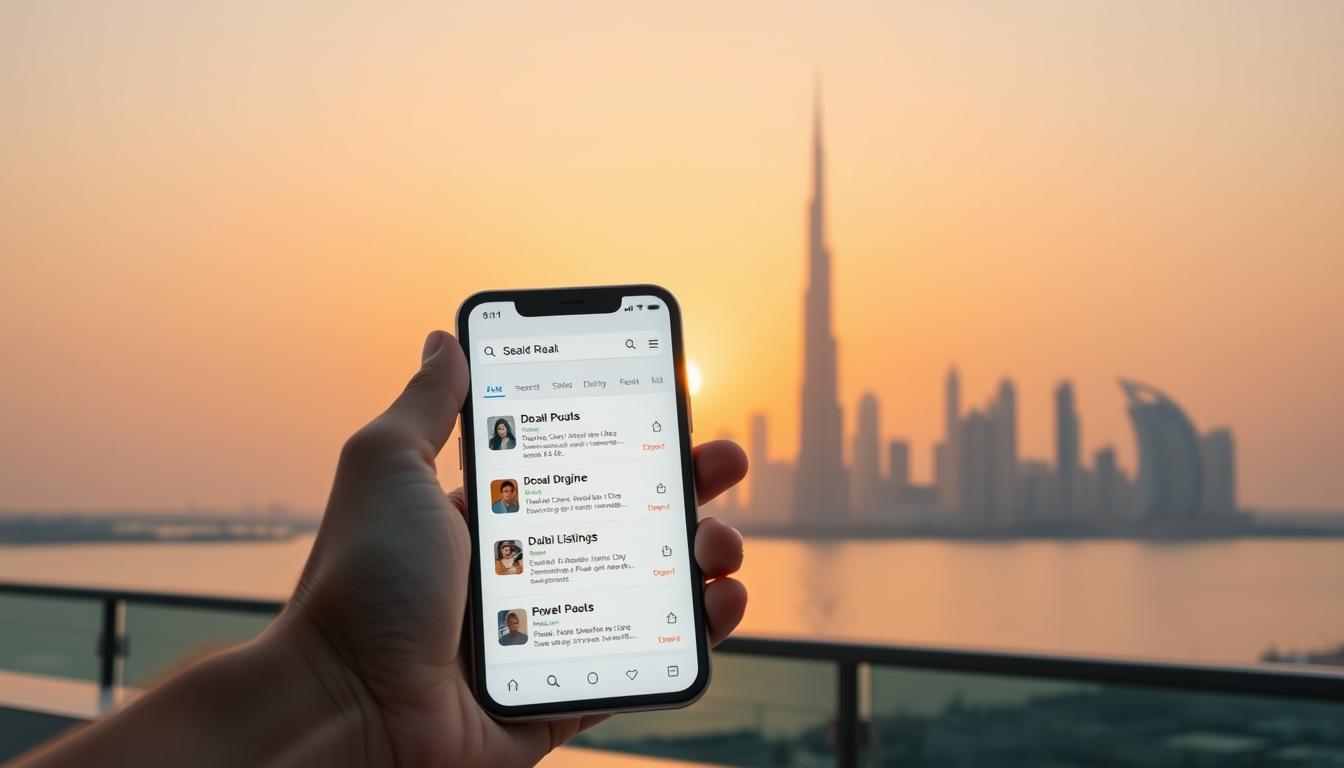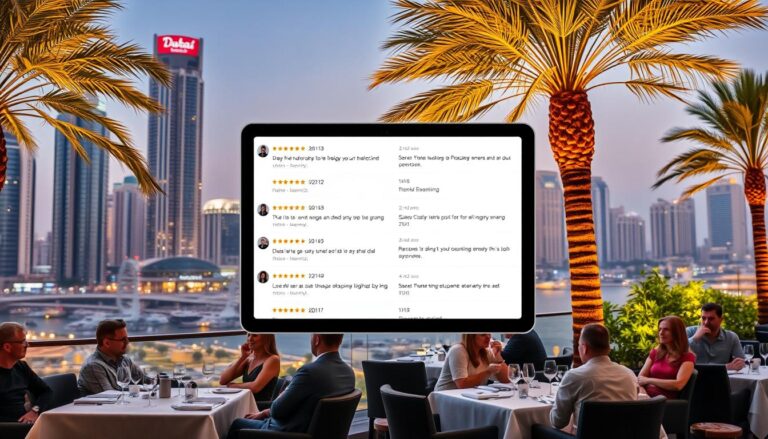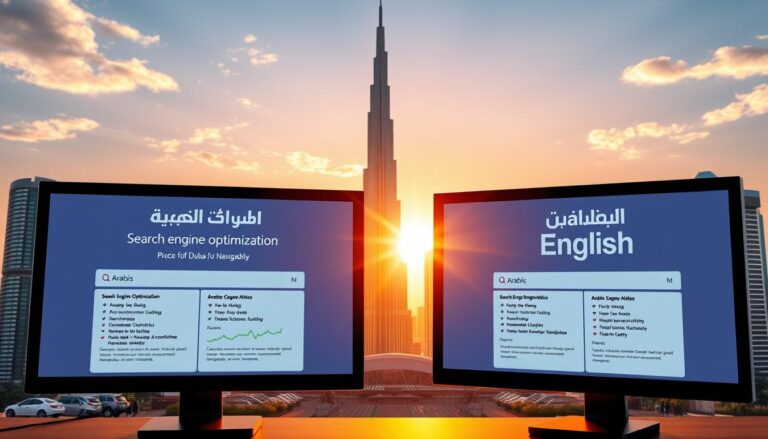Local Keyword Research for Dubai Property Developers: Expert Guide

Can we truly turn search intent into steady, qualified leads for developers in a crowded market?
We answer that by showing how focused seo and measurement move listings from discovery to inquiry. In the United Arab Emirates, mobile users browse maps and search results while deciding where to visit or call.
Our guide explains how to match neighborhood demand with on‑page content, Google Business optimization, and a pragmatic tools workflow using planners and analytics. We map how searches evolve from broad exploration to high‑intent results and how a responsive website and compressed images improve conversion on phones.
We also outline the metrics we track in Google Search Console so our business decisions stay data driven. Read on to learn a repeatable process that helps developers win visibility, drive qualified traffic, and turn search interest into visits and calls.
Why local SEO matters for Dubai property developers right now
High competition in the city means broad listings no longer cut it — relevance and speed do. The market now favors teams that match neighborhood intent with fast pages and crisp on‑page content.
Voice search and mobile browsing reshape how people find services. Projections show voice queries rising past 60% and about 80% of UAE users on mobile. By optimizing our Google Business Profile and website, we boost visibility in Maps and organic search, improving results and lead quality.
We treat this as a program, not a one‑time task. Aligning community pages with buyer intent raises qualified traffic and reduces reliance on portals. That change cuts acquisition costs and creates steady calls and viewing requests.
- Faster discovery in Maps and Search
- Higher conversion from neighborhood-focused content
- Integration with sales and marketing for measurable leads
| Discovery Channel | Primary Action | Leading Metric |
|---|---|---|
| Maps | Call / Directions | Calls per week |
| Organic Search | View listing / Request | Viewing requests |
| Community Pages | Engage / Book visit | Form submissions |
Understanding user intent across the Dubai buyer journey
Understanding how intent shifts during a buyer’s journey helps us match pages to real needs.
We map three clear stages: discovery, comparison, and transaction. At discovery, users browse wide searches about neighborhoods, price bands, and lifestyle trade-offs. That content should explain area benefits and typical commute time to major hubs.
At comparison, people check schools, amenities, and commute. We design pages that answer those questions plainly. This helps google search surface concise answers and improves click-throughs from mobile “near me” actions.
How we align content and listing pages
- Informational guides map discovery-stage searches to neighborhood profiles and price bands.
- Comparison pages focus on schools, transit times, and amenity checklists for people weighing options.
- Transactional pages push clear CTAs—saved listings, booked viewings, and contact forms—so users move forward fast.
| Stage | User intent | Page focus | Metric to track |
|---|---|---|---|
| Discovery | Learn about areas and lifestyle | Neighborhood guides, FAQs, commute times | Impressions & organic clicks |
| Comparison | Compare schools, amenities, commute | Comparison pages, amenity lists, maps | Time on page & saved listings |
| Transaction | Book visits or call | Listing pages with CTAs and contact | Calls, viewing requests |
We pull queries from Google Search Console to tune on-page copy and FAQs. That way our audience finds concise answers, and each page points to the next logical step in the buyer journey.
Core concepts: connecting listings to hyper-local searches
We design each neighborhood page to act like a map and a salesperson, answering specific buyer questions fast.
That means structuring pages around demand in Downtown Dubai, Business Bay, Dubai Marina, and Palm Jumeirah so users see relevant options when they search. We pair tidy titles, clear headers, and schema markup so search engines read context correctly.
Neighborhood-driven demand
- Match each location with a dedicated page and concise descriptions.
- Use photos and brief CTAs tailored for mobile to improve click through and calls.
- Keep NAP and location data consistent across profiles and on-site modules.
Search results anatomy
Maps, organic links, and rich snippets each reward different signals. Maps favor complete profiles and reviews. Organic results need strong on‑page content and fast pages. Rich results require structured data and clear answers.
| Surface | Main Signal | Primary Action |
|---|---|---|
| Maps | Profile completeness | Call / directions |
| Organic | Content relevance | View listing / read guide |
| Rich snippets | Schema & FAQs | Quick answers / high CTR |
How to build a high-impact keyword universe for real estate
We group search phrases into clear clusters so each page answers a single buyer need. This reduces overlap and raises match quality for search and seo. We validate ideas with tools and real market trends before we publish content.
Brainstorming categories: area + property type + features + intent
- Combine an area name with a product type and a feature to form focused phrases.
- Use intent markers like “for sale,” “near metro,” or “sea view” to spot buyers ready to act.
- Map those phrases to specific pages on the website to avoid cannibalization.
Long-tail and transactional modifiers that convert
Prioritize long-tail terms that show buying intent. Examples include “serviced apartments Downtown” and “3‑bedroom beachfront property Jumeirah.” These convert better than broad search queries.
Seasonal and trend-led terms informed by market shifts
Track spikes with Google Trends and AnswerThePublic. Plan timely guides and update titles when intent rises. This keeps our industry content fresh and aligned with search demand.
| Modifier Type | Example | Page Target |
|---|---|---|
| Feature | “sea view” | Listing + gallery |
| Transit | “near metro” | Neighborhood guide |
| Transaction | “for sale now” | Listing with CTA |
Tools stack for Dubai market research
We use a compact toolset to turn search signals into a prioritized roadmap for websites and business services. The stack blends volume data, competitor analysis, question discovery, and trend spotting so our work maps directly to market demand.
Google Keyword Planner + Site explorers
We pull UAE volumes in Google Keyword Planner and break them down by neighborhood names. Then we validate competitiveness with Ahrefs and SEMrush to find content gaps and realistic opportunities.
AnswerThePublic & Google Trends
AnswerThePublic gives us question-based searches to build FAQ and featured-answer content.
Google Trends surfaces rising topics and seasonality so we schedule timely landing pages and articles.
- Segment search intent: informational, commercial, transactional.
- Benchmark competitors with Site/Keywords explorers and plan gap content.
- Monitor traffic and query shifts via Google Search Console to refine targets.
| Tool | Main use | Output | Impact |
|---|---|---|---|
| Google Keyword Planner | Volume by neighborhood | Seed list & bid estimates | Data-driven page targeting |
| Ahrefs / SEMrush | Difficulty & competitor gaps | Priority content list | Higher ranking probability |
| AnswerThePublic | Question discovery | FAQ and snippet targets | Improved CTR from search |
| Google Trends / GSC | Spikes & query validation | Editorial calendar & refinements | Faster capture of traffic shifts |
local keywords dubai property: seed list to page mapping
Assigning each seed phrase to a page type prevents overlap and helps the website rank more reliably.
We divide search intent into three page classes: community hubs, area guides, and listings. Each class serves a single purpose, from overview to transaction.
Mapping keywords to community pages, listings, and area guides
We allocate seed terms to the right page type so content matches intent. Community hubs provide broad context and link to active listings.
Area guides answer long‑tail questions, include FAQs, and surface amenities tied to neighborhoods like Downtown Dubai and Dubai Marina.
Core listings remain transactional: clear CTAs, compressed media, and schema that protects their ranking signals.
Avoiding cannibalization with clear topical silos
- Design silos per area so pages do not compete for the same search intent.
- Use consistent naming for URLs, headers, and breadcrumbs to reinforce the location hierarchy on the website.
- Apply internal linking standards so individual properties roll up to their location hub and strengthen relevance.
- Employ canonical tags where similar inventory could otherwise create duplicate pages.
- Review the mapping quarterly and update based on search performance and inventory shifts.
| Page Type | Main Goal | Primary Signal |
|---|---|---|
| Community Hub | Overview & navigation | Area authority, internal links |
| Area Guide | Informational, long‑tail intent | FAQ, amenities, schema |
| Listing | Contact / booking | Transactional content, structured data |
Google Business Profile mastery for real estate visibility
A properly claimed Business Profile turns search results into direct calls and scheduled visits. We start by claiming and verifying the profile, then complete NAP, categories, and service areas so our listing appears in relevant map packs.
Complete NAP, categories, services, and neighborhood coverage
We populate the business profile with exact contact details, office hours, and service entries that reflect what we sell in each neighborhood. This boosts visibility and reduces mismatches when people search on mobile.
Photos, 360° tours, and Posts that drive calls and visits
We upload high-quality media and 360° tours with consistent file names to showcase listings and improve engagement. Regular Posts highlight new units and area guides to capture timely interest.
Reviews strategy: prompts, responses, and keyword-rich social proof
We ask satisfied clients to mention neighborhood names and specific features when they review. We reply to all feedback to build trust with people and to show active management to google business and search engines.
Tracking local pack performance by area and property type
We monitor local pack results by location and category, and add UTM tags to attribute calls and site visits. Monthly audits refresh media, services, and Posts so results stay aligned with inventory changes.
| Signal | Primary Action | Metric |
|---|---|---|
| Complete profile | Update NAP & categories | Map pack impressions |
| Media & tours | Upload photos / 360° | Clicks to website |
| Reviews & Posts | Solicit + respond | Calls per week |
On-page SEO for property listings and area pages
Well-crafted on-page elements make pages easier for search engines and users to scan fast.
We write titles and H1–H3 that mirror neighborhood intent and feature clear modifiers like “sea view” or “near metro.” Meta descriptions highlight the unique offer and include a short CTA to boost click-through rates.
We implement schema for properties, businesses, and breadcrumbs so search engines parse page purpose and surface rich snippets. This includes Property, Offer, and BreadcrumbList markup on listing pages and Organization data for offices.
Practical on-page checklist
- Titles and headers that include intent without stuffing keywords.
- Meta descriptions standardized to state neighborhood, unit type, and CTA.
- Schema for listings, business info, and breadcrumbs to clarify page roles.
- Short example FAQs and amenity lists to capture featured snippets.
- Alt text for images that describes apartments, views, and nearby POIs.
| Element | Purpose | Metric |
|---|---|---|
| Title / Meta | Improve CTR on search results | Click-through rate |
| Schema | Enable rich results and clarity | Impressions in SERP features |
| Internal links | Strengthen topical clusters and navigation | Pages per session |
We separate discovery pages from transactional listings in the website structure. This prevents signal dilution and helps estate teams measure what drives calls or viewing requests. Finally, we monitor performance and iterate copy based on query data so pages keep improving.
Content strategy: pages that win Dubai’s real estate searches
Strong neighborhood pages turn casual searches into serious inquiries by answering practical buyer questions.
Community guides and area pages
We build focused guides for Downtown Dubai and Dubai Marina as well as Business Bay and Palm Jumeirah. Each guide links to active listings and explains lifestyle, commute times, schools, and nearby services.
Investment and off-plan coverage
We publish short investment explainers and off‑plan updates timed to market news. These pieces highlight expected returns, timeline risks, and buyer profiles so investors and families can decide faster.
Media-rich pages that engage
High-quality images, short videos, and virtual tours are central to our content. Media suits mobile browsing in the city and raises time on page for apartments and listings.
- Guides that connect to listings and lead capture on our website.
- Trend-aware updates that match market cycles and events.
- Structured sections so readers — whether ’re investors or families — find key info quickly.
| Page Type | Main Benefit | Primary Signal |
|---|---|---|
| Community Guide | Area context & links to properties | Authority & internal links |
| Investment Post | Market insight & timing | Timely relevance |
| Media Hub | Higher engagement | Images, video, virtual tours |
Technical and mobile optimization for UAE users
Fast mobile experiences are now a deciding factor for people browsing listings across the city. We focus on technical fixes that reduce load time and improve engagement for on‑the‑go users.
Core Web Vitals and responsive UX for faster search results
We target Core Web Vitals thresholds so search engines and people see faster results. That lowers bounce rates and raises conversion from mobile sessions.
We streamline scripts, prioritize critical CSS, and set performance budgets per template. This keeps each website page snappy as inventory scales.
Image compression and grid layouts that perform on mobile
We compress media to balance quality and speed. Modern formats and responsive srcset reduce payload for phones while keeping visual appeal.
Our grids use a two‑column desktop layout that stacks to one column on tablet and phone. This improves scannability and tap accuracy for people using touch screens.
- Compress images and serve next‑gen formats for lower bandwidth use.
- Design tap‑friendly CTAs and short forms to convert mobile traffic.
- Test maps and filters on small screens so location controls remain usable.
- Monitor speed and conversions in analytics to tie performance to visibility gains.

| Focus | Action | Benefit | Metric |
|---|---|---|---|
| Core Web Vitals | Reduce LCP, FID, CLS | Faster rendering for users | Page speed & mobile conversions |
| Responsive layout | Grid collapse to single column | Improved readability on phones | Time on page & form completions |
| Media optimization | Compress images, lazy load | Lower bounce and better traffic quality | Bounce rate & pages per session |
Voice search and semantic SEO for 2025-ready discoverability
As more people speak their searches, we must craft answers that mirror natural questions and intent. Conversational content helps us reach an audience that expects short, spoken replies.
Conversational queries and question keywords
We adapt copy to how people ask questions: who, what, where, and how. That means plain language, concise answers, and FAQs written in full sentences.
Structured FAQs target featured answers and voice results. We track which voice-style queries drive clicks and refine phrasing for clarity and brevity.
Entity and topic clusters to strengthen relevance
We group topics into clusters by neighborhood, unit type, and amenities to build clear semantic signals. This helps search engines link related pages and improves snippet chances.
We use trends data to pick which questions to answer first, map short answers to deeper guides, and align each response with commercial pages for better conversion.
| Action | Signal | Benefit |
|---|---|---|
| Conversational FAQs | Natural sentences | Featured answers & voice |
| Entity clusters | Structured topics | Stronger relevance |
| Schema & headings | Context clarity | Improved SERP results |
Local competition analysis: finding gaps and opportunities
We audit top portals and agencies to see which content formats actually win clicks and leads.
Using tools like SEMrush and Ahrefs, we map who dominates target areas and which pages appear in google search features.
Benchmarking against portals and agencies in target areas
We reverse‑engineer ranking pages from portals such as Bayut and Property Finder and leading agencies. This shows the title patterns, media sets, and FAQ formats that drive traffic.
SERP feature analysis: Maps, snippets, and image packs
We check which competitors win Maps, featured snippets, and image packs. That tells us whether schema, concise summaries, or richer galleries will improve our visibility.
- Identify who leads key neighborhoods and which content types produce results.
- Spot market gaps in hyper‑targeted pages rather than broad listings.
- Prioritize work that feeds high‑value lead flows for the business.
| Competitor | Top feature | Strength |
|---|---|---|
| Major portal | Image packs & organic links | High volume listings, broad reach |
| Top agency | Maps & Reviews | Strong local trust signals |
| Specialist site | Featured snippets | Deep guides for areas like dubai marina |
Social and community signals that boost local authority
Social engagement now shapes how our listings are discovered and trusted across the city. We use social platforms and community channels to extend reach, drive clicks, and gather genuine feedback that supports search visibility.
Google Business Posts, social media targeting, and UGC
We publish Google Business Posts to spotlight new units and neighborhood updates. Those posts prompt actions and lift profile clicks.
On Instagram and TikTok we tailor media to each platform: short videos for reels and carousel galleries for feeds. This helps people see quality visuals and sparks shares.
Engaging forums and groups with value-first insights
We join city forums and groups to answer questions and share useful content, not ads. Helpful replies build trust and encourage mentions that boost credibility.
- Tailor media per platform; use short-form video and carousels that resonate with people.
- Target audience segments precisely to align creatives with intent.
- Cultivate UGC and testimonials that mention areas and amenities.
- Repurpose content and measure results by engagement and profile actions.
| Channel | Tactic | Metric |
|---|---|---|
| Instagram / TikTok | High-quality reels & carousels | Engagement & saved posts |
| Google Business | Posts + updates | Profile clicks & calls |
| Forums & Groups | Value-first answers | Mentions & referral traffic |
Tracking and measuring performance the smart way
We measure what matters so our marketing spend turns into real viewings and calls.
Google Search Console: impressions, clicks, and query insights
We use Google Search Console to see which queries drive impressions and clicks. That lets us match queries to pages and refine copy for better results.
Local rank tracking by neighborhood and device
We track rankings by neighborhood and by device to spot proximity and mobile effects. This shows us where listings gain visibility and where competition is stronger.
Lead quality metrics: calls, forms, and viewing requests
We prioritize lead quality over raw traffic. Calls, form submissions, and booked viewings are our primary metrics.
- Tag Google Business links with UTM parameters so calls and visits attribute correctly.
- Monitor time windows and seasonality to adjust campaigns and editorial timing.
- Benchmark results against competition and reallocate effort to high-potential listings.
| Signal | Metric | Action |
|---|---|---|
| Search Console | Impressions & clicks | Refine page copy and meta |
| GBP & website | Clicks, calls, visits | UTM attribution & landing page test |
| Rank tracking | Position by device | Adjust local targeting and UX |
We keep dashboards that combine search engines data, Google Business Profile interactions, and onsite conversions. Each month we iterate the plan based on what the data proves works.
Iterate and evolve: adapting to Dubai market shifts
Adapting to rapid market changes means testing new areas and media to capture fresh intent. We use data from Trends, Search Console, and competitor moves to set priorities and act fast.

Updating trends, content, and listings with fresh data
We review trends and performance on a fixed schedule so our work reflects current demand. That saves time and reduces wasted effort.
We prune outdated pages, consolidate thin content, and retune listings when inventory or offers change. This protects estate authority and improves results.
Testing new neighborhoods, amenities, and formats
We run small, time-boxed experiments across areas and media to find incremental wins. Winning experiments become standard playbooks and free up resources for new tests.
| Neighborhood | Amenity angle | Format | Expected results |
|---|---|---|---|
| Business Bay | Near metro & co-working | Short video + guide | Higher clicks & viewing requests |
| Dubai Marina | Sea view & family features | Virtual tour + FAQ | Longer time on page, better leads |
| Palm Jumeirah | Investment returns | Short analysis post | More qualified investor inquiries |
Conclusion
When we align marketing, site UX, and business profiles, visibility gains turn into measurable results and steady leads. We focus on clear signals for search engines, fast mobile pages, and content that answers intent.
Our roadmap—research, mapping, GBP mastery, on‑page work, technical fixes, and tracking—creates compounding gains for the business. That approach helps agencies and estate teams compete with portals and own demand directly.
Act now, whether ’re scaling a new development or expanding an established portfolio. Persist, measure, and iterate: those habits link SEO work to revenue and long‑term results.





